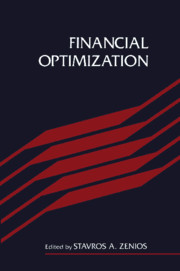Book contents
- Frontmatter
- Contents
- List of contributors
- Foreword
- Preface
- Acknowledgments
- Part I General overview
- Part II Models
- Part III Methodologies
- 10 Incorporating transaction costs in models for asset allocation
- 11 Bond portfolio analysis using integer programming
- 12 Scenario immunization
- 13 Mortgages and Markov chains: a simplified evaluation model
- 14 Parallel Monte Carlo simulation of mortgage-backed securities
- Index
13 - Mortgages and Markov chains: a simplified evaluation model
Published online by Cambridge University Press: 09 February 2010
- Frontmatter
- Contents
- List of contributors
- Foreword
- Preface
- Acknowledgments
- Part I General overview
- Part II Models
- Part III Methodologies
- 10 Incorporating transaction costs in models for asset allocation
- 11 Bond portfolio analysis using integer programming
- 12 Scenario immunization
- 13 Mortgages and Markov chains: a simplified evaluation model
- 14 Parallel Monte Carlo simulation of mortgage-backed securities
- Index
Summary
Introduction
The market for fixed-income securities has changed dramatically over the last decade. Two of the most significant changes have been the unprecedented volatility of interest rates and the introduction of mortgage-backed securities. The mortgage market has grown in the last decade from virtually nothing to become a substantial segment of the fixed-income market. There are nearly $1 trillion of these securities outstanding, or about half the total of US Treasury and Agency securities. See Person (1989), for example.
These developments have led to substantial innovations in the techniques used to analyze the values of fixed-income securities. Specifically, a collection of techniques known as option-pricing methods has come to be widely applied. This approach was developed originally to evaluate stock options, hence the name, but in fact it can be applied to any security whose value is affected by fluctuating economic variables.
The starting point is a stochastic-process model of the evolution of these variables over time. In fixed-income analysis the key variable is the short-term interest rate, though many models include other variables as well. Based on this model and the characteristics of the particular security being analyzed, one then derives a valuation equation. The solution of this equation provides an estimate of the value of the security under various conditions. A full exposition of this approach can be found in Ingersoll (1987), for example.
- Type
- Chapter
- Information
- Financial Optimization , pp. 309 - 324Publisher: Cambridge University PressPrint publication year: 1993



